In this research have found several types of clients, which were came to take varies type of service from FPAB.
A. Socio-economic & demographic Information of respondents
Table A.1: Age distribution of respondents
| Age (Years) |
Frequency |
Percentage |
| 10-20 |
15 |
25.00% |
| 20-30 |
25 |
41.67% |
| 30-40 |
16 |
26.67% |
| 40-50 |
4 |
6.67% |
| Total |
60 |
100.00% |
Figure A.1: Age of respondents
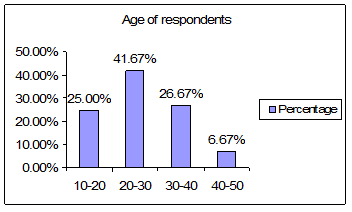
Research found that 15 respondents from the age group of 10yrs-20yrs, 25 respondents found 20yrs-30yrs, 16 respondents were from 30yrs-40yrs and 4 respondents were from 40yrs-50yrs age group.
Table A.2: Marital status of respondents
| Situation |
Frequency |
Percentage |
| Married |
46 |
76.67% |
| Unmarried |
14 |
23.33% |
| Divorcee |
0 |
0.00% |
| Widow |
0 |
0.00% |
| Others |
0 |
0.00% |
| Total |
60 |
100.00% |
Figure A.2: Marital status of respondents
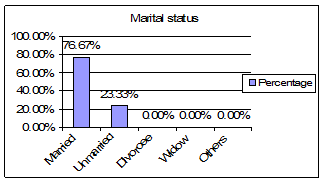
In this research have found married respondents 76.67% whereas unmarried respondents were 23.33%. On the other hand, there were no respondents from divorcee, widow & others.
Table A.3: Religious status of respondents
| Religion |
Frequency |
Percentage |
| Islam |
57 |
95.00% |
| Hindu |
3 |
5.00% |
| Buddhist |
0 |
0.00% |
| Christian |
0 |
0.00% |
| Total |
60 |
100.00% |
Figure A.3: Religion of respondents
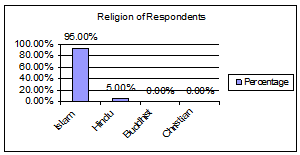
There were 95.00% Muslim respondents whereas Hindu respondents were only 5.00% but there were no respondents from Buddhist and Christian.
Table A.4: Educational qualification of respondents
| Qualification |
Frequency |
Percentage |
| Illiterate |
7 |
11.67% |
| Primary |
10 |
16.67% |
| SSC |
25 |
41.67% |
| HSC |
9 |
15.00% |
| Graduate |
9 |
15.00% |
| Total |
60 |
100.00% |
Figure A.4: Educational qualification of respondents
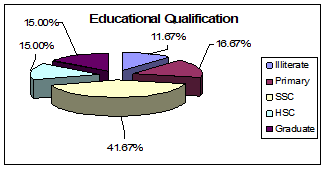
Among 60 respondents, 41.67% have completed SSC, 16.67% respondents are Primary educated whereas 11.67% respondents are illiterate and rest 30% equally divided for HSC & Graduate. They are either graduate or completed HSC.
Table A.5: Occupation of respondents
| Occupation |
Frequency |
Percentage |
| Service |
12 |
20.00% |
| Business |
5 |
8.33% |
| Day Labor |
0 |
0.00% |
| Housewife |
28 |
46.67% |
| Student |
4 |
6.67% |
| Unemployed |
0 |
0.00% |
| Others |
11 |
18.33% |
| Total |
60 |
100.00% |
Figure A.5: Occupation of respondents
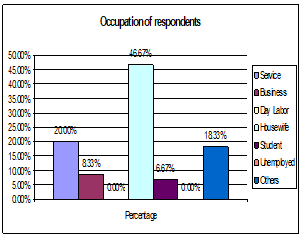
Maximum respondents in this research are housewife. Their percentage is 46.67% whereas I have found, 20.00% respondents are doing job, 8.33% respondents do business, 6.67% respondents are student and 18.33% respondents answered others option in this question.
Table A.6: Income range of respondents
| Income |
Frequency |
Percentage |
| 5000-10000 |
35 |
58.33% |
| 10000-15000 |
6 |
10.00% |
| 15000-20000 |
7 |
11.67% |
| 20000-30000 |
5 |
8.33% |
| 30000 & More |
7 |
11.67% |
| Total |
60 |
100.00% |
Figure A.6: Income range of respondents
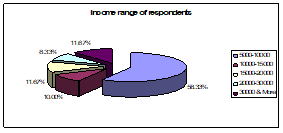
It has been seen in this research people who come in FPAB, maximum numbers of them are from lower income group. In this research have found that incomes for 58.33% respondents are between BDT5000 & BDT10000. 10.00% earn BDT10000-BDT15000, 11.67% earn BDT15000-BDT20000, 8.33% respondents earn BDT20000-BDT30000 and income for rest 11.67% are more than BDT30000.
B. Information about the user of Family planning
B.1. Eligibility of respondents about Family planning’s
In this research have found 50 respondents are eligible to answer the question about family planning. It means these 50 (83.33%) respondents are related or suppose to be related with family planning concept. And rest 10 (16.67%) respondents are not eligible to answer family planning component use related question.
Table B.2.1: User of contraceptives in present
| Response |
Frequency |
Percentage |
| Yes |
36 |
72.00% |
| No |
14 |
28.00% |
| Total |
50 |
100.00% |
Figure B.2.1: User of contraceptives in present
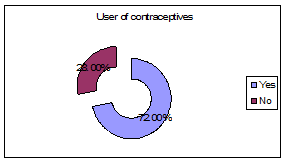
In this research have found that 83.33% respondents are eligible for family planning, among them 72.00% respondents use contraceptives and 28.00% respondents do not use the same.
Table B.2.2: Method of contraceptives
| Method |
Frequency |
Percentage |
| Permanent |
1 |
2.78% |
| Temporary |
35 |
97.22% |
| Total |
36 |
100.00% |
Figure B.2.2: Method of contraceptives
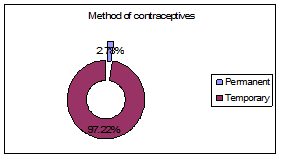
There are 36 respondents, who use contraceptives. Among them only one (2.78%) respondent use permanent method and rest 97.22% respondents still dependents on temporary contraceptives.
Table B.3: Types of Temporary contraceptives
| Type |
Frequency |
Percentage |
| Pill |
12 |
34.29% |
| Condom |
8 |
22.86% |
| Injection |
10 |
28.57% |
| Norplant |
3 |
8.57% |
| Others |
2 |
5.71% |
| Total |
35 |
100.00% |
Figure B.3: Types of Temporary contraceptives
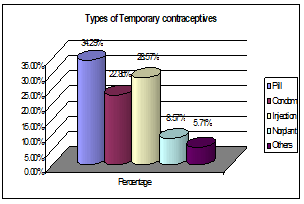
Total number of temporary contraceptive user is 35, where 34.29% respondents take Pill, 28.57% take injection, 22.86% respondents use condom, 8.57% respondents has chosen Norplant as contraceptive and 5.71% respondents are depends on other types of contraceptives.
Table B.4: Difficulty to use contraceptives
| Problems Face |
Frequency |
Percentage |
| Yes |
11 |
30.56% |
| No |
25 |
69.44% |
| Total |
36 |
100.00% |
Figure B.4: Difficulty to use contraceptives
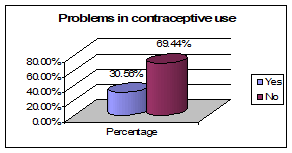
It has been seen that there are 36 respondents who use contraceptives, among them 30.56% respondents face problems during their uses and rest 69.44% respondents never face problem in using contraceptives.
Table B.5: Decision maker for contraceptive use
| Person |
Frequency |
Percentage |
| Both |
11 |
30.56% |
| Husband |
15 |
41.67% |
| Wife |
6 |
16.67% |
| Doctor |
2 |
5.56% |
| Others |
2 |
5.56% |
| Total |
36 |
100.00% |
Figure B.5: Decision maker for contraceptive use
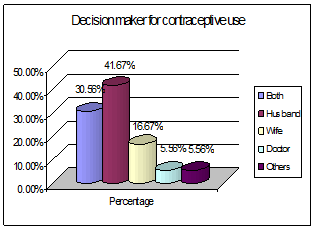
In our society, we know usually man dominates on women. The same thing has been observed regarding to take decision about to use contraceptives. It has seen in 41.67% cases husband took decision to use contraceptives whereas wives took decision in 16.67% cases. In 30.56% cases decision has been taken by both husband & wife. In 5.56% cases decision has been take for contraceptive use by doctor and 5.56% respondents answered others option in this question.
Table B.6: Main user of contraceptive in the Family
| User |
Frequency |
Percentage |
| Both |
2 |
5.56% |
| Husband |
9 |
25.00% |
| Wife |
25 |
69.44% |
| Total |
36 |
100.00% |
Figure B.6: Main user of contraceptive in the Family
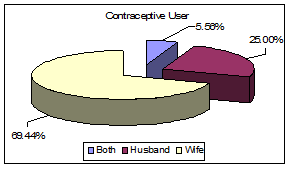
We usually think that women use more contraceptive than man. In this research this idea has been proved again. It has found 69.44% contraceptive users are women whereas only 25.00% users are man and in case of rest 5.56% user, it has seen both, husband & wife use contraceptives.
Table B.7: Opinion to use permanent contraceptive in future.
| Response |
Frequency |
Percentage |
| Yes |
12 |
24.00% |
| No |
38 |
76.00% |
| Total |
50 |
100.00% |
Figure B.7: Opinion to use permanent contraceptive in future
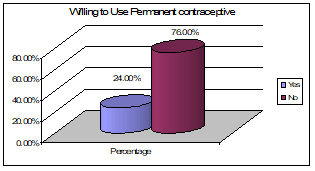
In our society most of the people do not want to use permanent contraceptives. In this research 76.00% respondents deny to use permanent contraceptives in future but 24.00% respondents answered positively to use permanent contraceptives.
Table B.8: Take service before coming FPAB abut Family Planning
| Service receive |
Frequency |
Percentage |
| Yes |
37 |
74.00% |
| No |
13 |
26.00% |
| Total |
50 |
100.00% |
Figure B.8: Take service before coming FPAB abut Family Planning
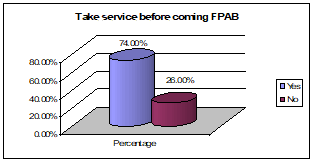
There were 50 respondents who are eligible to answer Family planning related questions. Among them 74.00% respondents has taken service from other organization before coming to FPAB and 26.00% respondents has never taken any services from any other organization.
Table B.9: Know about ongoing program of Family planning
| Response |
Frequency |
Percentage |
| Yes |
32 |
64.00% |
| No |
18 |
36.00% |
| Total |
50 |
100.00% |
Figure B.9: Know about ongoing program of Family planning
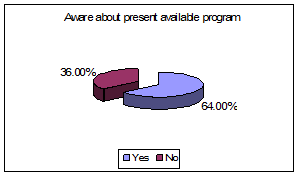
There are 64.00% (32) respondents who know about present family planning programs. And 36.00% respondents do not know about any present family planning program.
C. Information about Safe Mother Hood
C.1: Total Respondents about Safe Motherhood
In this research, the researcher found 41 (68.33%) respondents are eligible to answer about safe motherhood and 19 (31.67%) respondents are not eligible to answer about safe motherhood.
Table C.2: Face problem during pregnancy
| Face Problem |
Frequency |
Percentage |
| Yes |
9 |
21.95% |
| No |
32 |
78.05% |
| Total |
41 |
100.00% |
Figure C.2: Face problem during pregnancy
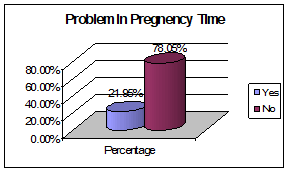
21.95% respondents out of 41 respondents has faced problem during their pregnancy and 78.05% respondents did not face any problem in pregnancy period.
Table C.3: Weight of the children in delivery period
| Proper weight |
Frequency |
Percentage |
| Yes |
29 |
70.73% |
| No |
12 |
29.27% |
| Total |
41 |
100.00% |
Figure C.3: Weight of the children in delivery period
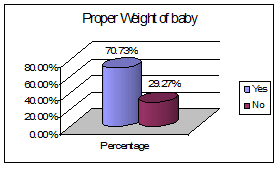
29 Respondents means 70.73% respondents out of 41 respondents who are eligible to answer the question of safe motherhood has answered that their baby has been born in proper weight, but 29.27% respondents answered that their baby has been born in under weight.
Table C.4: Get proper Food & Rest in pregnancy period
| Proper Food & Rest |
Frequency |
Percentage |
| Yes |
33 |
80.49% |
| No |
8 |
19.51% |
| Total |
41 |
100.00% |
Figure C.4: Get proper Food & Rest in pregnancy period
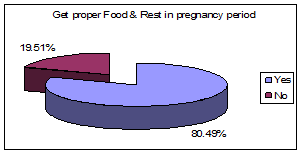
In the study seen that 41 respondents has related with pregnancy. It have found 80.49% respondents out of that 41 have got proper food & rest in their pregnancy period. Besides, 19.51% answered that they did not get the same.
Table C.5: Place of children’s delivery
| Place of Delivery |
Frequency |
Percentage |
| Hospital |
7 |
17.07% |
| Clinic |
13 |
31.71% |
| Mud Home |
9 |
21.95% |
| Brick built Home |
12 |
29.27% |
| Total |
41 |
100.00% |
Figure C.5: Place of children’s delivery
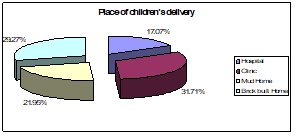
It has been found through this research that 17.07% delivery has been done in Hospital, 31.71% has been done in clinic, 21.95% has been done in mud home and 29.27% has been done in brick built home.
D. Information about Sexual & Reproductive Health
Table D.1: Suffering disease in STD/STI of respondents
| Response |
Frequency |
Percentage |
| Yes |
0 |
0.00% |
| No |
60 |
100.00% |
| Total |
60 |
100.00% |
Figure D.1: Suffering disease in STD/STI of respondents
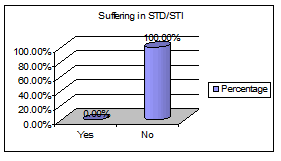
As per this research, findings there were no respondents found who suffer in disease of STD/STI.
Table D.2.1: Knowledge about sexual disease of respondents
| Response |
Frequency |
Percentage |
| Yes |
53 |
88.33% |
| No |
7 |
11.67% |
| Total |
60 |
100.00% |
Figure D.2.1: Knowledge about sexual disease of respondents
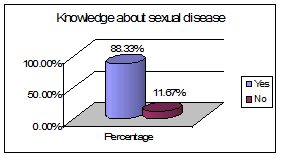
Though In the study period, did not get any respondents who are suffering in disease of STD/STI, there 88.33% respondents who has knowledge about sexual disease. However, it has found 11.67% respondents do not have knowledge sexual disease.
Table D.2.2: Knowledge about the name of STD
| Name of STD |
Frequency |
Percentage |
| Gonorrhoea |
37 |
23.27% |
| Syphilis |
32 |
20.13% |
| Horpis |
6 |
3.77% |
| Hepatitis B |
29 |
18.24% |
| Aids |
55 |
34.59% |
| Others |
0 |
0.00% |
| Total |
159 |
100.00% |
Figure D.2.2: Knowledge about the name of STD
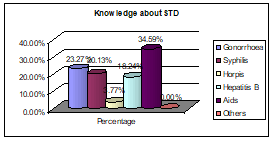
It has been found through this research, 53 respondents have knowledge about STD/STI. We have come to know from them that they know about five types of disease. In the study found someone who knows about more than one disease. Considering all responses it has come to know that maximum percentage has come for AIDS, it got 34.59%, 18.24% response has come for Hepatitis B, 20.13% response has come for Syphilis and 23.27% and 3.77% has come for Gonorrhoea and Horpis respectively.
Table D.3: Necessity to get treatment from doctor when symptom of STD/STI found
| Response |
Frequency |
Percentage |
| Yes |
60 |
100.00% |
| No |
0 |
0.00% |
| Total |
60 |
100.00% |
Every respondent has given their opinion to have doctors’ consultation when any symptom of STD/STI found. We have come to know some symptoms of STD/STI from our respondents. These are, wound in reproductive organ, lump with pain in reproductive organ, itching in reproductive organ and lump without pain in reproductive organ
Table D.4: Opinion about any one effect by STD
| Opinion |
Frequency |
Percentage |
| Hide the Disease |
0 |
0.00% |
| Take advice from Doctor |
60 |
53.57% |
| Hiding is not good |
43 |
38.39% |
| Others |
9 |
8.04% |
| Total |
112 |
100.00% |
Figure D.4: Opinion about any one effect by STD
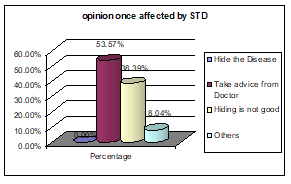
It has found in this research, 53 respondents have knowledge about STD/STI. It has come to know from what to do once is affected by STD. It has found none who supports to hide the disease. 53.57% response has come in favor of to take advice from doctor, 38.39% response has come for “Hiding is not good” and rest 8.04% response has come for others.
Table D.5: Opinion about Prevention of Sexual Diseases
| Opinion |
Frequency |
Percentage |
| Condom Use |
47 |
32.64% |
| Trust to Partner |
35 |
24.31% |
| Keep away from Wicked Practice |
22 |
15.28% |
| Not use Public Toilet |
33 |
22.92% |
| Others |
7 |
4.86% |
| Total |
144 |
100.00% |
Figure D.5: Opinion about Prevention of Sexual Diseases
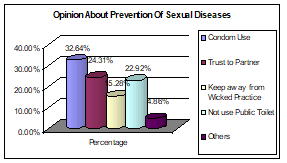
There are some opinions have come to prevent sexual disease. It has found four opinions about this, on the other hand, some one answered others in this question, and the percentage of this answer is 4.86%. 32.64% opinions have come to use condom, 24.31% have come to be trusted to partner, 22.92% response have come for not to use public toilet and 15.28% responses have come to Keep away himself/herself from Wicked Practice
E. Information about Abortion
Table E.1: Total respondents about Abortion
| Respondents |
Frequency |
Percentage |
| Applicable |
6 |
10.00% |
| Not Applicable |
54 |
90.00% |
| Total |
60 |
100.00% |
Figure E.1: Total respondents about Abortion
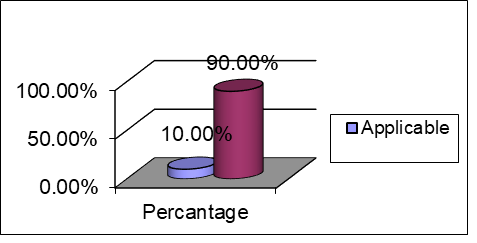
There are 60 respondents in our research. When I wanted to know about abortion, It has found 10.00% respondents applicable for this information and 90.00% respondents are not applicable for this field.
E. 2. Number of Abortion
The study had a plan to know how many abortions are done. It has found 2 (33.33%) respondents among 6 respondents did abortion twice and 4 (66.67%) respondents did abortion only one time. However, on the time of data collection, did not find anyone who did abortion thrice or four times.
E.3. Situation of Last Abortion
There are various situations of abortions. Someone abortion live child on the other hand some abortion death child. In this research I have found, 3 respondents means 50.00% respondents did abortion their live child whereas 1 (16.67%) respondents did it for death child. And rest 2 (33.33%) respondents did MR.
E. 4. Present number of live child
Those who did abortion, some of them have child in present. It has found 2 (33.33%) respondents have one child, 2 (33.33%) respondents have two children, 1 (16.67%) respondents have three and 1 (16.67%) respondents have four children.
E. 5. Reason behind Abortion/MR
There are various reasons behind abortion/MR, I have found three reasons. There are Failure of contraceptive, Want child Later and Do not want anymore child. It has found equal number means 2 (33.33%) of respondents for each reason.
E.6. Reason not to use contraceptive
The respondents were asked why did not they choose contraceptives instead of abortion? There are only 1 (16.67%) respondents replied that they forget to use contraceptives. 3 (50.00%) respondents told, their husband dislike contraceptives. Moreover, 1 (16.67%) respondents replied that it happens for their misunderstanding and rest 1 (16.67%) respondents told that it happens for lake of their awareness.
E.7. Take any step for Abortion before MR
It has known that 6 persons did abortion/MR their child. Among them 2 (33.33%) respondents took step for abortion before MR and 4 (66.67%) respondents did not try for abortion.
E.8.1. Number of respondents to face problem after MR
It has seen, there are 3 (50.00%) respondents faced problems after MR and another 3 (50.00%) respondents did not face problem.
E.8.2. Type of the problem after MR
It has found that there are 3 respondents who faced problem after MR, among them 1 (25.00%) respondents suffered in abdominal pain and another 2 (75.00%) respondents has suffered in fever.
E.9. Expenditure for MR
Expenditure plays vital role in family planning. In the study wished to get an idea about the expenditure of MR. the study have been informed, 4 (66.67%) respondents paid BDT201-BDT300 for MR and rest 4 (33.33%) respondent paid BDT401-BDT500.
E.10. Bear of expenditure for MR
It has seen maximum respondents in our research have come from low income group. So, it is very important to know how they bear their MR expenses. It has been answered 3 (50.00%) respondents bear the expenses of MR from their own savings. And another 3 (50.00%) answered that they bear the expenses from other sources. But the study did not find anyone who take lone for MR expenses.
F. Information about New Born Care
F.1. Total Respondents about new born information
Researcher had some questions about care of newborn baby. In this research, we have found 48.33% respondents are applicable for this type of questions. In addition, another 51.67% respondents are not applicable to answer the question of this field.
F.2. New Born is the First child
Researcher have seen, in case of newborn baby 13 (44.83%) respondents told that it is their first baby and another 16 (55.17%) respondents told that it is not their first baby.
F.3.1. Face problem after birth
Researcher have found that 10 (34.4%) respondents out of 29 respondents, who are eligible to answer about new born baby face problem after birth and another 19 (65.52%) respondents did not face problem after birth.
F.3.2. Name of disease after born
Researcher have identified, 10 respondents told that their baby face problem after birth. Among them maximum, 4 (40.00%) respondents suffered in catch cold, whereas 2 (20.00%) respondents suffered in Pneumonia, 1 (10.00%) respondent suffered in Measles, 2 (20.00%) respondents suffered in Bronchitis and 1 (10.00%) respondent suffered in Catarrh.
F.4.1. Number of respondent’s child to take Vixen
There are 10 (34.48%) respondents out of 29 respondents has given vixen their baby and rest 19 (65.52%) respondent did not arrange vixen for their baby.
F.4.2. Knowledge about the name of the Vixen of respondents
There are only 6 (20.69%) respondents who know the name of vixen and rests 23 (79.31%) do not know the name of vixen.
F.5.1.Other food given in parallel with breast feeding
Breast feeding is essential for every baby. It is advised not to take any other food without breast feed up to six month from birth. We have seen 18 (62.07%) respondents did not feed their baby other food in parallel with breast feeding. And 11 (37.93%) respondents give their baby other food with breast feeding.
F.5.2. Name of food feed to children
When parents give their baby, other food parallel with breast feeding they want to give them best available food. In our research, we have found four different foods which are given baby. Maximum respondents love to give rice to their baby. I have found 5 (45.46%) respondents give rice whereas vegetable is given by 2 (18.88%), liquid food is given by 2 (18.88%) & box milk is given by 2 (18.88%) respondents.
F.6. Knowledge about program for children of respondents
In our country, maximum people cannot use available service due to lake of awareness. In this research, it has seen 12 (41.38%) respondents do not know about the available service for newborn baby care. However, 17 (58.62%) respondents answered that they are aware about presently available newborn baby care services.
F.7. Satisfaction for ongoing service for children
There are 11 (37.93%) respondents who ranked the available baby care service as medium, 10 (34.48%) respondents considered as satisfactory whereas 5 (17.24%) respondents considered as good and 3 (10.34%) respondents avoid to answer above three option, they answered others option.
G. Information about Adolescence
G.1. Total number of respondents
In this research, it had a field to get information from adolescence. It has found 10 (16.67%) respondents are applicable for this field and rest 50 (83.33%) respondents are not applicable to answer the question of this field.
G.2. Knowledge about Adolescence of respondents
Researcher have seen 7 (70.00%) respondents have heard about age transition period concept but 3 (30.00%) respondents answered that they did not hear about this concept. Respondents who heard about age transition period, they have heard about this from their brother-sister, parents grandparents, and someone told that they have known by reading book.
G.3. Get knowledge about Adolescence from parents
In our society, it is very difficult to get proper knowledge about age transition period. Sometimes our parents also do not share this type of information with their child. I have seen 5 (50.00%) respondents answered that they got knowledge from their parents about the care of adolescence. And another 5 (50.00%) respondents told that they did get any knowledge about this from their parents.
G.4. Take care by parents in puberty period of respondents
7 (70.00%) respondents answered that their parents has taken care them in their puberty period. But 3 (30.00%) respondents replied, they did not get any help from their parents in puberty period.
G.5. Awareness about sexuality
There is a debit in our society whether adolescents should be given knowledge about the idea of sexuality. People are divided in this issue. I have seen 9 (90.00%) respondents supported to give knowledge to adolescent about the idea of sexuality. On the other hand, 1 (10.00%) respondents deny giving this knowledge to adolescent.
G.6. Knowledge about take care of Adolescence period
7 (70.00%) respondents answered, they know how to care adolescent on the other hand 3 (30.00%) respondents do not know the caring process of adolescent.
G.7. Knowledge about the reason of changing in Puberty period
I have found 6 (60.00%) respondents know the reason of physical changes and rests 4 (40.00%) do not have any idea about the changes.
G.8. Necessity of entertainment
In this research every adolescent (10 respondents) answered that entertainment is required for their mental development. Moreover, it will keep them away from crime.
H. Information about Opinion & Recommendations
Table H.1: Knowledge about the program of sexual & reproductive health of FPAB
| Opinion |
Frequency |
Percentage |
| Yes |
43 |
71.67% |
| No |
17 |
28.33% |
| Total |
60 |
100.00% |
Figure H.1: Knowledge about the program of sexual & reproductive health of FPAB
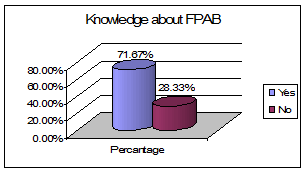
FPAB serves this country in sexual and reproductive health. However, still some people do not know about the program of FPAB for sexual and reproductive health. The researcher found in this research that 28.33% respondents do not know about program for sexual and reproductive health. On the other hand, 71.67% respondents answered that they know about the program of FPAB for sexual and reproductive health.
Table H.2: Satisfaction about the program of FPAB
| Opinion |
Frequency |
Percentage |
| Fully Satisfied |
3 |
5.00% |
| Satisfied |
39 |
65.00% |
| Medium |
9 |
15.00% |
| Not Satisfied |
2 |
3.33% |
| No Opinion |
5 |
8.33% |
| Others |
2 |
3.33% |
| Total |
60 |
100.00% |
Figure H.2: Satisfaction about the program of FPAB
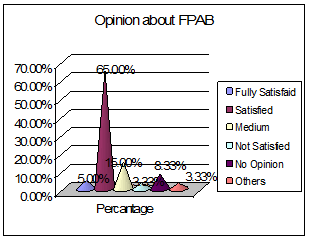
We know FPAB gives quality sexual and reproductive health. It has found 65.00% respondents who considered the service of FPAB as satisfied and 5.00% respondents considered as fully satisfied. On the other hand, only 3.33% respondents answered that they are not satisfied to the service of FPAB. 15.00% respondents considered FPAB services as medium, 3.33% respondents answered others option in this question. In addition, 8.33% respondents did not give their opinion for this question.
Major Findings of Research
Maximum service receive are under graduate. The percentage of under graduate is maximum service receiver are housewife, second highest service receiver are service women. The maximum clients of FPAB are from lower or middle income group. People are interested to take temporary contraceptives instead of permanent contraceptives and maximum people take pill, condom and injection. Norplant is unusual contraceptives. In present situation is changing, some people take contraceptive in joint decision. However, until now women are the highest user of contraceptives.
It has found, Maximum people did not take any problem and the weight of newborn baby was sufficient. Presently we see not pregnant women get support from family member, they get sufficient food and rest. We have seen technological development also pushes there do to family planning. Now maximum babies born in Hospital or clinic.
Present generation is census about sexual disease. Now people are also aware about disease and the consequences of the sexual disease.
Abortion is increasing day by day. Some people died abortion, twice/thrice. There are some people, who tried for abortion before MR.
Though maximum people do not know the essential vixens’ name, they do not forget to take vixens by doctors or health workers. Most of the people are now satisfied with present availed services.
In our society, present people are becoming aware about necessity and the problems of adolescence. Parents take care their child in this regard but they do not face conflict to give them knowledge about adolescence our sexuality.
FPAB plays a great role in service of sexual & reproductive health. General people are aware and satisfied about their service. However, still there are some areas to be improved in FPAB. Science maximum client of FPAB are from lower or middle income group, the services should be free. Alternatively, it should have special program for lower income group.





























